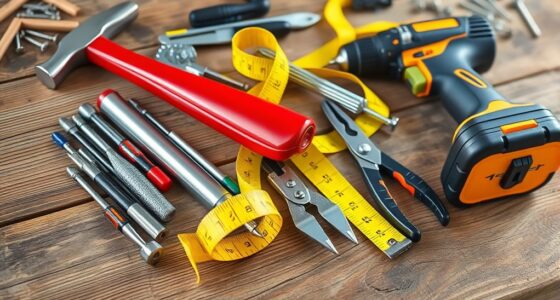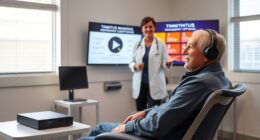To write effective notes in noisy work environments, focus on active listening and use digital tools to stay organized. Utilize noise-canceling headphones, find quieter spots, and keep your tools ready for quick input. Avoid transcribing everything; instead, capture main ideas, decisions, and action items. Consider recording conversations or using templates for efficiency. By combining these strategies, you’ll better manage distractions and improve your note quality—discover how to optimize this process even further.
Key Takeaways
- Use noise-canceling headphones to block out background noise and maintain focus.
- Develop a structured digital note-taking system with templates for quick, organized capturing of key points.
- Focus on active listening by identifying main ideas and restating information in your own words.
- Record conversations when possible to review details later and fill in note gaps.
- Keep digital tools ready for rapid annotation and quick access to relevant information during noisy environments.

Taking effective notes is a skill that can considerably boost your understanding and retention of information. When you’re working in a noisy environment, capturing what’s important becomes even more demanding. That’s where digital note-taking tools and active listening come into play. Digital note-taking allows you to quickly jot down key points without the hassle of flipping through paper or losing track of your thoughts. Plus, the ability to organize, search, and annotate notes digitally helps you stay on top of essential information despite distractions.
Active listening is vital in noisy work settings. It involves fully concentrating on what’s being said rather than passively hearing background noise or multitasking. When you listen actively, you filter out irrelevant sounds and focus on the speaker’s main ideas, which makes your note-taking more targeted and effective. During meetings or conversations, avoid the temptation to write down everything verbatim. Instead, focus on capturing main concepts, key decisions, and action items. Restating information in your own words helps reinforce your understanding and creates more meaningful notes.
In a noisy environment, it’s helpful to develop a note-taking system tailored to your needs. Using digital tools, you can create templates for different types of meetings or topics, allowing you to quickly organize your notes without missing critical details. Features like voice recording, if available, can be invaluable—enabling you to record conversations for later review when the noise subsides. This way, you can listen to the recording and fill in any gaps in your handwritten or typed notes, ensuring accuracy without sacrificing focus during the meeting.
You’ll also want to minimize external distractions as much as possible. Use noise-canceling headphones or find a quieter spot if you can. Engage in active listening by maintaining eye contact with the speaker and nodding occasionally to show you’re engaged. Keep your digital tools open and ready, so you can swiftly type or annotate notes as ideas emerge. Remember, the goal is not to transcribe everything but to capture the essence of what’s being said, so your notes serve as a useful reference later. Additionally, understanding the role of technology in note-taking can help you choose the most effective tools to enhance your focus and efficiency in challenging environments.
Frequently Asked Questions
How Can I Ensure My Notes Are Understood Without Verbal Clarification?
To make certain your notes are understood without verbal clarification, focus on clarity enhancement by writing clearly and concisely. Use visual cues like bullet points, numbering, or highlighting key information to make your notes easier to scan and interpret. Keep your language straightforward, avoid jargon, and consider including diagrams or symbols where appropriate. This approach helps others grasp your message quickly, even in noisy environments, reducing the need for additional explanations.
What Tools Are Best for Taking Notes in Noisy Environments?
In noisy environments, you should use tools like voice recognition software to capture your notes accurately and quickly. Noise-canceling headphones help block out distractions, allowing you to focus on your recordings or transcriptions. Combining these tools guarantees you can take clear, effective notes without missing details. You’ll find it easier to stay organized and communicate your ideas, even amidst background noise.
How Do I Prioritize Information When Taking Quick Notes?
When taking quick notes, you should use prioritization strategies to decide what’s most important. Focus on key points, deadlines, and action items first, helping you make quick decisions and avoid clutter. Use abbreviations and symbols to save time, and leave details for later. By honing your ability to identify high-priority info fast, you’ll enhance your efficiency and ensure critical details aren’t overlooked in noisy, fast-paced settings.
Can Digital Notes Be More Effective Than Handwritten Notes in Noisy Settings?
In noisy environments, digital notes often outperform handwritten ones, offering digital efficiency and easy organization. While handwritten authenticity captures personal nuance, digital tools let you quickly search, edit, and sync across devices. You’ll find that digital notes reduce clutter and help you stay focused amid chaos, making them more effective for capturing essential information swiftly. Embrace digital solutions to enhance your note-taking, even when noise makes traditional methods challenging.
How Do I Organize Notes for Easy Retrieval Later?
To organize your notes for easy retrieval, start with clear categorization by topics or projects. Use color coding to quickly identify key areas or priorities, making scanning faster. Keep related notes together and create a logical hierarchy or tagging system. Regularly review and update your organization method to stay efficient. This approach helps you find the right information swiftly, even in a busy, noisy environment.
Conclusion
Now that you know how to write effective notes in noisy environments, imagine the difference it could make when vital information slips through the chaos. Will your notes be clear enough to prevent mistakes? Or will the noise drown out the details you need? The secret lies in mastering these techniques—you never know when your next critical insight might depend on it. Stay prepared, stay sharp, and let your notes be your hidden advantage.











